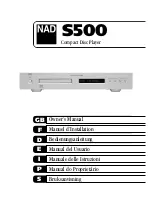
64
JUNE 2002
SOUND & VISION
Day on DVD via the progressive-scan out-
put, I saw a sharp, defined picture with out-
standing color integrity and range of con-
trast. The image quality was terrific, with
finely detailed shadows in the countless
scenes shot inside the Monte Carlo where
about half the movie seems to take place.
The speeding car passes Denzel and Ethan
Hawke’s faces through a myriad of differ-
ent lighting conditions and back-
grounds; the DVD 50 showed
every one to excellent advan-
tage. And its slo-mo scan-
ning was as smooth and
steady as on any player
I’ve used.
I was unable to see any
difference between the pro-
gressive-scan component-
video output of the Har-
man Kardon player and
that of my reference pro-
gressive-scan player —
a widely respected sin-
gle-disc model that
costs around three
times as much. I did
an A/B comparison
using three DVDs of
which I had duplicate
copies, including the visu-
ally stunning Crouching Tiger, Hidden
Dragon. The same held true even with test
patterns from Ovation Software’s Avia
DVD. In short, I simply saw no difference
between the players, which means that the
DVD 50’s progressive-scan video perfor-
mance is top-shelf. It should perform no
less well — within the limitations of the
signal formats — if you use standard inter-
laced component-, composite, or S-video
connections.
On the audio side, the only issue I exam-
ined was the quality of stereo CD playback,
though most buyers will probably use a
digital link, which means they’ll be listen-
ing to the digital-to-analog conversion per-
formed by their receiver or surround proc-
essor. Nonetheless, the DVD 50 was an
equally excellent CD player. Stereo play-
back of known, high-resolution recordings
was clean, detailed, and quiet.
Most of what’s left to talk about here are
the kinds of things that distinguish most
DVD players from each other these days:
functions, features, and ease of use. Fortu-
nately, the Harman Kardon DVD 50 has
plenty to offer in these areas.
It played every CD-R and CD-RW that I
tried without a hiccup, including those
with MP3 files. It offers a useful onscreen
display for MP3 discs, showing an alpha-
betized list of filenames, though it “flat-
tened” the file structure, at least on the
discs I burned, showing all files at the same
level regardless of any heirarchical folders.
You can program a playlist of up to 60
MP3 tracks, in any order, which is cool.
Unfortunately, they can’t be from more
than one disc. And you can’t play MP3
tracks in random order from either one disc
or multiple discs. That said, since the DVD
50 takes nearly a minute to initialize each
MP3 disc — like all other MP3-capable
DVD players I’ve encountered — not hav-
ing the options of multidisc MP3 program-
ming or random play makes sense.
As if in compensation, there’s an unus-
ually flexible shuffle-play menu for audio
CDs (or DVDs — but does anybody ever
actually play DVD chapters at random?).
You get a choice of single-disc shuffle, all-
discs shuffle (one disc at a time), or a mode
that plays two randomly selected tracks
from Disc A, then two from Disc B, then
two from C, and so on until all tracks from
all discs have been played, without repeats
— pretty clever. Track/chapter program-
ming is similarly flexible. You can program
a playlist with up to 22 steps from any or
all discs in any order, freely mixing stan-
dard CDs, DVDs, and even Video CDs (but
not CDs containing MP3 files).
Programmability for DVD playback
may appeal to the rare music-video addict,
but I suspect most people will use the DVD
50 as a CD changer for music and as a sin-
gle-disc player, at least most of the time,
for movies and videos. On the audio side,
it worked like any good changer. Disc-to-
disc access time was about par (a maxi-
mum of 17 seconds), but track-skip time
was under a second and response to play
and pause commands was equally snappy.
Overall, the ergonomic design is very
good. The onscreen operation bar (nearly
universal these days), with icons that give
you access to all the important modes and
displays, worked well. More important, the
test report
H I G H P O I N T S
Excellent progressive-scan
video performance.
Smooth fast and slow video scanning.
Useful onscreen controls for
DVD, CD, and MP3 playback.
Nice remote control.
L O W P O I N T S
No direct disc selection on remote.
Slow access to high-speed search.
The Harman Kardon DVD 50 provided
Oscar-worthy image quality for Denzel
Washington’s bad cop in Training Day.
DVD-VIDEO PERFORMANCE
Measurements were made from a variety of
DVD test discs, all through the player’s
composite-video output except as noted.
Maximum-white level error....................+1 IRE
Setup level....................+7.5/0 IRE (switchable)
Luminance frequency response
(re level at 1 MHz)
at 4 and 5 MHz.....................................–0.26 dB
at 6 and 6.75 MHz (DVD limit)..............–0.63 dB
Differential gain ............................................2%
Differential phase ..........................................2°
Onscreen horizontal resolution ........540 lines
In-player letterboxing................................poor
Component-output level error (interlaced
mode, Y/P
r
/P
b
) ...................+4.85/–1.67/–1.59%
Component-output timing error (interlaced
mode, P
r
/P
b
) .......................+4/+4 nanoseconds
in the lab
The DVD 50’s stereo audio output (figures
omitted for space) was very good to excellent
all around. The one curiosity was its analog
output level, which at 1 volt was 6 dB shy of the
de facto 2-volt standard, but this should have
little or no effect on real-world dynamic range.
Performance through its composite-video
output was slightly better than average thanks
to the flatness of its luminance frequency
response, which always translates to more
accurate reproduction of very fine image detail.
Its component-video output was also unusually
accurate in level and timing. It could play record-
able DVD-R and rewritable DVD-RW discs
recorded in standard DVD-Video mode as well
as DVD+RW discs. — D.K. and David Ranada





















